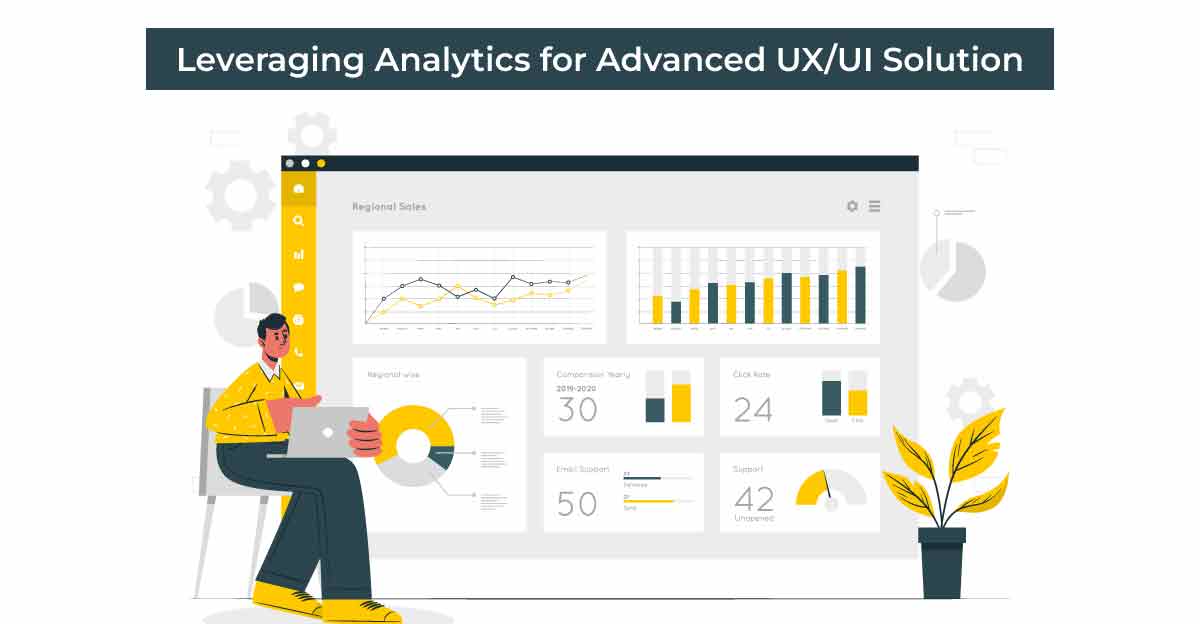In today’s digital landscape, user experience (UX) and user interface (UI) design play a pivotal role in the success of digital products and services. Understanding user behavior, preferences, and interactions is crucial for creating engaging and intuitive interfaces. Leveraging analytics for advanced UX/UI solutions has become increasingly important in achieving these objectives. In this article, we will explore the significance of data-driven design, the role of analytics in UX/UI solutions, and how to leverage analytics effectively for enhanced user experiences.
Analytics for Advanced UX/UI Solutions:
Leveraging Data for Enhanced Digital Experiences:

Understanding Data-Driven UI/UX Design
What is data-driven design?
Data-driven design is an approach that relies on insights derived from user data and analytics to inform design decisions. Instead of relying solely on intuition or assumptions, designers use quantitative and qualitative data to understand user behavior, preferences, and pain points.
Benefits of data-driven UI/UX design
Data-driven UI/UX Design offers several benefits, including improved user satisfaction, increased engagement, higher conversion rates, and better decision-making. By analyzing user data, designers can identify areas for improvement, prioritize features, and tailor experiences to meet user needs effectively.
1. Improved User Satisfaction:
By analyzing user behavior and feedback, designers can gain insights into what aspects of the user experience are working well and what needs improvement. Addressing pain points and optimizing the interface based on data can lead to a more satisfying user experience.
2. Increased Engagement:
Understanding how users interact with the interface allows designers to create more engaging experiences. By leveraging data on user preferences, behaviors, and patterns, designers can design interfaces that capture users’ attention, encourage exploration, and foster longer interaction sessions.
3. Higher Conversion Rates:
Data-driven design enables designers to identify friction points in the user journey and optimize the interface to streamline the conversion process. By analyzing user data related to conversion metrics, such as click-through rates, form completions, or purchases, designers can make informed decisions to improve conversion rates.
4. Better Decision-Making:
Data-driven insights provide designers with objective information to inform their design decisions. By collecting and analyzing quantitative and qualitative data, designers can validate design hypotheses, prioritize design improvements, and make decisions based on evidence rather than assumptions or personal preferences.
5. Personalized Experiences:
Data-driven design allows for the creation of personalized experiences tailored to individual user preferences and behaviors. By segmenting users based on demographic information, past interactions, or other relevant data points, designers can deliver customized content, recommendations, and interactions that resonate with each user, ultimately enhancing the overall user experience
Examples of successful data-driven design implementations
Companies like Amazon, Netflix, and Spotify are prime examples of successful data-driven design implementations. These companies leverage vast amounts of user data to personalize recommendations, optimize user flows, and enhance overall user experiences.
Importance of Analytics for Advanced UX/UI Solutions

How analytics drive decision-making in UX/UI design
Analytics provide valuable insights into user behavior, such as how users navigate through a website or app, which features they engage with the most, and where they encounter friction points. By analyzing this data, designers can make informed decisions to optimize the user experience and achieve business goals.
Utilizing analytics to understand user behavior
Analytics tools like Google Analytics, Hotjar, and Mixpanel offer a wealth of data about user interactions, demographics, and preferences. Designers can use these tools to track user journeys, conduct A/B tests, and gather feedback to gain a deeper understanding of user behavior and motivations.
Improving user experience through data insights
By leveraging analytics insights, designers can identify usability issues, refine interface elements, and streamline user flows to create more intuitive and user-friendly experiences. Continuous monitoring and analysis of user data enable designers to iterate and refine designs based on real-world user feedback.
Leveraging Analytics for UX/UI: Best Practices
Collecting relevant data
To effectively leverage analytics for UX/UI design, it’s essential to collect relevant data that aligns with your design objectives and key performance indicators (KPIs). This may include user interactions, conversion rates, bounce rates, and qualitative feedback.
Analyzing user interactions
Once data is collected, it’s crucial to analyze user interactions to identify patterns, trends, and areas for improvement. Heatmaps, session recordings, and user surveys can provide valuable insights into user behavior and preferences.
Implementing changes based on analytics findings
Based on analytics findings, designers can prioritize design changes and optimizations to address pain points, improve usability, and enhance overall user satisfaction. A data-driven approach ensures that design decisions are grounded in empirical evidence rather than guesswork.
UI/UX Design Course in Jaipur: Incorporating Analytics
Overview of UI/UX design courses in Jaipur
Aspiring designers in Jaipur can benefit from specialized UI/UX Design Courses In Jaipur offered by leading institutes and training centers. These courses cover fundamental design principles, tools, and methodologies essential for creating compelling digital experiences.
Integration of analytics into the curriculum
To stay ahead in today’s competitive design landscape, UI/UX design courses in Jaipur are increasingly incorporating analytics modules into their curriculum. Students learn how to use analytics tools effectively to optimize user experiences and drive business outcomes.
Benefits of learning data-driven design in Jaipur
By learning data-driven design principles in Jaipur, aspiring designers gain a competitive edge in the job market and are better equipped to tackle real-world design challenges. They learn how to harness the power of data to create impactful and user-centric designs that deliver measurable results.
Case Studies: Advanced UX/UI Solutions Through Analytics
Case study 1: E-commerce platform optimization
By analyzing user data and behavior on an e-commerce platform, designers identified friction points in the checkout process and implemented streamlined workflows. This led to a significant increase in conversion rates and overall user satisfaction.
Case study 2: Mobile app redesign
Through A/B testing and user feedback analysis, designers revamped the user interface of a mobile app to improve navigation and usability. The redesigned app saw a surge in user engagement and positive reviews.
Case study 3: Website revamp
By conducting usability tests and analyzing user journeys, designers identified usability issues on the website and implemented changes to enhance the overall user experience. This included optimizing page load times, simplifying navigation menus, and improving content layout. As a result, bounce rates decreased, and user engagement metrics showed significant improvement.
Tools and Technologies for Analyzing UX/UI Data
Google Analytics
Google Analytics is a powerful tool for tracking website traffic, user interactions, and conversion rates. It provides valuable insights into user behavior, demographics, and acquisition channels, helping designers make data-driven decisions to improve UX/UI design.
Hotjar
Hotjar offers heatmaps, session recordings, and user surveys to visualize user behavior and gather feedback. Designers can identify usability issues, pain points, and areas for improvement by analyzing user interactions in real-time.
Mixpanel
Mixpanel is a robust analytics platform that specializes in tracking user engagement and retention. Designers can use Mixpanel to analyze user journeys, segment audiences, and measure the impact of design changes on key metrics.
Adobe Analytics
Adobe Analytics provides comprehensive insights into user behavior across digital channels. Designers can track user interactions, conduct A/B tests, and create personalized experiences based on audience segmentation and behavioral data.
Challenges and Considerations
Privacy concerns
One of the primary challenges of leveraging analytics for UX/UI design is ensuring user privacy and data security. Designers must adhere to strict privacy regulations and ethical guidelines when collecting and analyzing user data to maintain user trust and confidentiality.
Data accuracy and interpretation
Another challenge is ensuring the accuracy and reliability of data collected through analytics tools. Designers must carefully interpret data findings and avoid making assumptions or generalizations without sufficient evidence to support their conclusions.
Continuous learning and adaptation
UX/UI design is a discipline that is always changing due to the frequent emergence of new technology, trends, and user behaviors. Designers must stay updated with the latest developments in analytics tools and methodologies to remain competitive and deliver cutting-edge design solutions.
Future Trends in Data-Driven UI/UX Design

AI and machine learning integration
AI and machine learning technologies are increasingly being integrated into analytics tools to automate data analysis, predict user behavior, and personalize user experiences at scale. This enables designers to deliver more personalized and adaptive design solutions.
Personalization and customization
Personalization is becoming increasingly important in UX/UI design, with users expecting tailored experiences that cater to their unique needs and preferences. Designers can leverage analytics insights to create personalized content, recommendations, and interactions that resonate with users on a deeper level.
Predictive analytics in UX/UI design
Predictive analytics enables designers to anticipate user needs, behaviors, and preferences based on historical data and patterns. By leveraging predictive analytics, designers can proactively optimize user experiences, anticipate user pain points, and deliver more intuitive and seamless design solutions.
Conclusion
In conclusion, leveraging analytics for advanced UX/UI solutions is essential for creating compelling digital experiences that meet user needs and drive business outcomes. By adopting a data-driven approach to design, designers can gain valuable insights into user behavior, identify areas for improvement, and deliver more impactful and user-centric design solutions. As technology continues to evolve, incorporating analytics into UX/UI design practices will become increasingly important for staying ahead in the competitive digital landscape.





